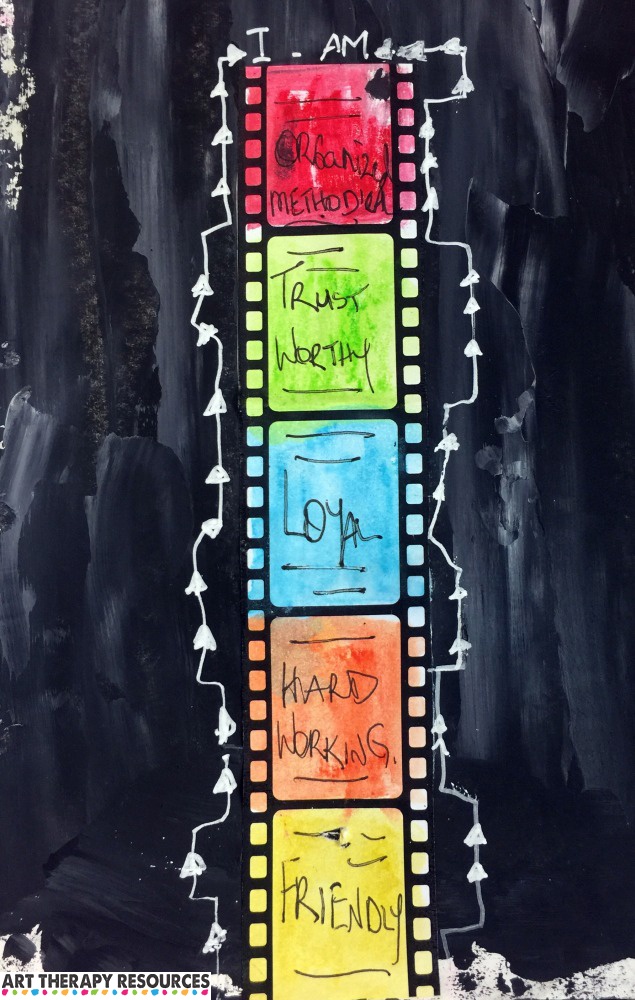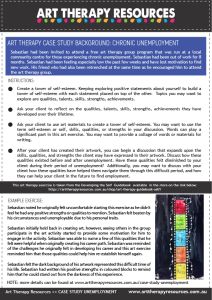THIS POST INCLUDES:
- Art Therapy and Unemployment
- About the Client
- Current Client Issues
- Art Therapy Exercise
- Client Insight and Outcomes
- Disclaimer
- FREE DOWNLOAD Art Therapy Exercise
ART THERAPY AND UNEMPLOYMENT
IMPACT OF UNEMPLOYMENT
Chronic unemployment or long term unemployment may vary in definition, however, it generally refers to those who have been unemployed for approximately 6 or more months. In some countries, governments determine chronic unemployment as longer than 12 months.
Chronic unemployment may not be a primary reason that many therapists see clients, however, it can form a part of a client’s overall background if a client seeks help for depression, anxiety or any other more common mental health issues.
In many situations, unemployment does not present as a singular problem. Instead, along with unemployment, many individuals will be experiencing a range of difficult life experiences that may splinter from unemployment such as family stress or breakdown, alienation, shame, social isolation, homelessness, and poor physical health. Long term unemployment increases the risk of depression, anxiety, and a generalized feeling of hopelessness.
Chronic unemployment has a significant impact on mental health and can affect different people along the various stages of their lifespan. For a younger person, they may be affected by significant self-esteem issues where they hold beliefs about their skill level and ability to integrate as an adult into society. For an older person, they may be confronted with stresses over financial obligations for themselves and their families. They may also be impacted by self-esteem issues if they are unable to quickly find employment that recognizes a lifetime of developed skills.
The most common areas that are affected by a person who is experiencing long term unemployment include:
- Self-esteem
- Relationships
- Identity
- Financial strain
- Isolation
- Anxiety (about the future)
- Depression (about the personal self)
- Shame and guilt
Most cultures value the role that work plays in our daily lives. From our work role, we can gain status, security, certainty, achievement, a strong sense of self. When these values are eroded through chronic unemployment, this can have a negative impact on our sense of well-being.
Unemployment can occur on an individual level, however, it can also impact entire communities when a large employer in a small community retrenches a significant portion of the workforce. This happens frequently in mining communities where life is focused on employment. In these communities not only do people lose their jobs but they also often lose their entire social circle as families may have to quickly relocate for other employment.
HOW ART THERAPY CAN HELP WITH CHRONIC UNEMPLOYMENT
Unemployment of any length can have a significant impact on an individual who is presented with constant disappointment in job seeking along with the enduring uncertainty of their physical, emotional, and financial security.
For those experiencing chronic unemployment, these experiences are further exacerbated by the length of time that this disappointment and uncertainty continues. As financial stresses increase over time, an individual can start to feel more desperate and hopeless.
Art therapy can help explore these tensions and help an individual develop an overall sense of resilience to the adverse outcomes that occur from unemployment.
Art therapy can help explore:
- Developing personal competence
- Self-esteem
- Self-worth
- Understanding identity
- Negative self-beliefs
- Acceptance
In addition to validating and exploring the emotional experience of chronic unemployment, art therapy can also help the client develop strategies and coping techniques to maintain a healthy level of motivation to pursue employment when hopelessness begins to develop.
This can mean exploring the internal and external sources of motivation that can help the client embrace positive influences on motivation ad combat obstacles to motivation.
Art therapy can help provide a space for clients who are experiencing chronic unemployment to gain insight into the impact of unemployment on their general physical and mental well-being. Exploring this impact can help clients understand any developing tensions in relationships that develop due to the stress of unemployment.
As art therapy involves undertaking activities with physical outcomes, clients are often engaging in activities that reinforce their ability to learn new skills and receive tangible outcomes through the process of creating art. This process has a significant impact on providing clients with a validation of their abilities and competence to take on new challenges.
Clients can also develop a sense of control over their outcomes through their choice of art materials and how they choose to express complex thoughts they may be experiencing.
Art therapy is a unique place without judgment and criticism and provided clients with an outlet for the internal pressures that may be building internally. The activity of creating art provides a container for clients to alleviate the worries and concerns that are kept within as they try and problem solve their position from unemployment to employment.
Art therapy can also provide an avenue for clients to develop problem-solving skills through the process of manipulating art materials. This can help develop insight for the client and emphasize their skills in translating this skill to other aspects of their life.
Below are two guidebooks that are available in the store that can provide further help when working with clients who may be experiencing long term unemployment:
ABOUT THE CLIENT
- Name: Sebastian
- Age: 39
- Summary of sessions to date: Sebastian had been invited to attend a free art therapy group program that was run at a local community centre for those experiencing chronic unemployment.
CURRENT CLIENT ISSUES
Sebastian had been out of work for 8 months. Sebastian had been feeling especially low the past few weeks and has lost motivation to find new work. His friend who had also been retrenched at the same time as Sebastian encouraged him to attend the art therapy group.
ART THERAPY EXERCISE
This art therapy exercise is taken from the Art Therapy Guidebook – Developing the Self.
Create a tower of self-esteem. Keeping exploring positive statements about yourself to build a tower of self-esteem with each statement placed on top of the other. Topics you may want to explore are qualities, talents, skills, strengths, achievements.
INSTRUCTIONS:
- Ask your client to reflect on the qualities, talents, skills, strengths, achievements they have developed over their lifetime.
- Ask your client to use art materials to create a tower of self-esteem. You may want to use the term self-esteem or self, skills, qualities, or strengths in your discussion.
- Words can play a significant part in this art exercise. You may want to provide a collage of words or materials for writing.
- After your client has created their artwork, you can begin a discussion that expands upon the skills, qualities, and strengths the client may have expressed in their artwork. Discuss how these qualities existed before and after unemployment. Have these qualities felt diminished to your client during their period of unemployment? Additionally, you may want to discuss with your client how these qualities have helped them navigate them through this difficult period, and how they can help your client in the future to find employment.
CLIENT INSIGHT AND OUTCOMES
Sebastian noted he originally felt uncomfortable starting this exercise as he didn’t feel he had any positive strengths or qualities to mention. He felt beaten by his circumstances and unemployable due to his personal traits. Sebastian initially held back in creating art, however, seeing others in the group participate in the art activity started to provide some motivation for him to engage in the activity.
Sebastian was able to name a few of his qualities that he felt were helpful when originally creating his career path. He was reminded of the challenges he originally felt in developing his career and this art exercise reminded him that those qualities could help him re-establish himself again.

DISCLAIMER
This case study represents a snapshot of the client’s progress in treatment. The exercise in this article could be used as written or as a guide for new and original tasks developed by the Art Therapist. Responsibility for treatment resides with the individual therapist who understands their clients specific needs. The art therapy exercise should not be viewed as a pre-defined directive on how to treat a client that presents with a specific range of problems. This art therapy exercise will help build a database of knowledge to draw upon when helping your client. Art Therapy is associated with psychotherapy techniques, however, each therapist often approaches therapy with their own foundation of psychological interventions, whether it be psychotherapy, CBT, DBT or other methods.
FREE DOWNLOAD: Art Therapy Exercise
Download the FREE Art Therapy Exercise based on the above Case Study. The free download includes instructions for the art therapy exercise, along with an example of the art therapy exercise.

BUILD YOUR ART THERAPY REFERENCE MATERIALS:
Pin this image to your Pinterest board.

SHARE KNOWLEDGE & PASS IT ON:
If you’ve enjoyed this post, please share it on Facebook, Twitter, Pinterest. Thank you!
